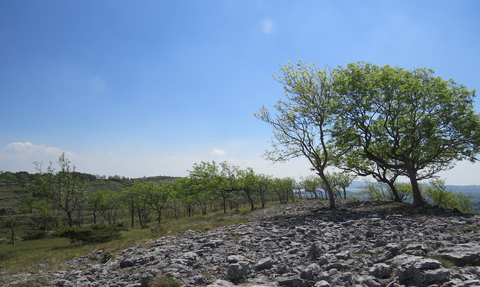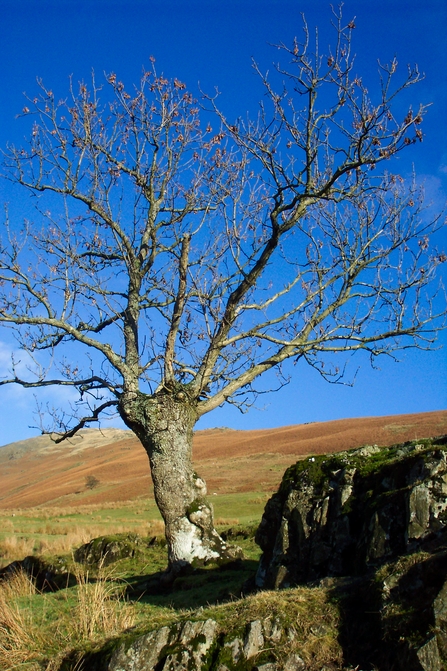
Ash dieback in Cumbria
How bad is ash dieback disease?
Sick and dying ash trees across our countryside are becoming a more common sight. As more and more ash trees become affected by ask dieback disease we'll start to see largescale change in our woodlands and hedgerows.
Evidence from Europe suggests that we will lose up to 80% of our ash trees to the disease.Cumbria Wildlife Trust
Please will you help our woodlands with a donation now?
What causes ash dieback?
Ash dieback is caused by a fungal pathogen, Hymenoscyphus fraxineus.
Where did ash dieback originate?
The fungus that causes ash dieback originated in eastern Asia where the native ash species are tolerant to it. Although affected by it, they're able to stop the disease before it enters the woody parts of the tree.
Our native ash, Fraxinus excelsior, does not have such protection and, as recent history across mainland Europe has shown, the fungus can have a devastating effect.
When did ash dieback start?
Although the fungus was only formally described in 2006, it has been present in Europe for 30 years and has devastated native ash populations, eventually being recognised in the UK for the first time in 2012.
How does ash dieback spread?
Fruiting bodies of the fungus appear between July and October as tiny white toadstools along the central stalk (rachis) of fallen leaves. These then produce spores that can travel tens of miles on the wind. When the spores land on ash leaves, the fungus spreads down the leaf stalk but occasionally also into the woody parts of the tree, eventually blocking water-carrying vessels below the bark and causing dieback above the infection. When the leaves fall in the autumn, the fungus overwinters in the leaf litter, producing more fruiting bodies the following summer, and reinfecting surrounding trees.
Where did ash dieback come from?
Although the disease may well have arrived in the UK from the continent by wind-blown spores, it was also brought in on imported ash saplings, until a ban was eventually implemented in 2012. Ash dieback is now evident in all parts of the UK, although some areas have been more severely affected than others.
What does ash dieback look like? Here's some pictures:
The outlook for ash trees
Evidence from Europe suggests that we will lose up to 80% of our ash trees to the disease. However, this could be a very slow and prolonged process, with affected trees potentially persisting for many years after first becoming diseased.
How does ash dieback kill trees?
Susceptible young or recently-coppiced trees are quickest to die because their narrow shoots are easily girdled by the fungus, and they are in closer proximity to the mushrooms releasing the spores. Mature susceptible trees will gradually show increasing levels of crown dieback, eventually reduced to epicormic shoots on their trunk.
In woodlands where honey fungus (Armillaria spp.) is present, this will attack and kill most trees weakened by ash dieback.
Can an ash tree recover from ash dieback?
Although no trees are immune to the disease, some trees appear to have much higher levels of tolerance, with an estimated 5% being usefully tolerant.
Such trees may also need tolerance to the emerald ash borer, an invasive beetle which has devastated North American ash populations and has been spreading westwards from an introduction in Moscow a number of years ago.
These tolerant trees and their progeny must be cared for and nurtured if we are going to keep and eventually restore ash back into the Cumbrian landscape.
Over 1,000 native wildlife species use or rely on ash in some way, at least 45 of which are entirely dependent on it for their survival.
The value of ash trees
Ash is a very important component of our woodlands, comprising 12% of native broadleaf woodland across the UK. It's also commonly found in parks, gardens and hedgerows across Britain.
Ash trees' ecological importance
Ash brings very specific habitat conditions to a wood. It's one of the last species to come into leaf, and the light, airy nature of an ash canopy allows many species to thrive on the woodland floor below.
Ash also has many species reliant upon it as a host. Over 1,000 native wildlife species use or rely on ash in some way, at least 45 of which are entirely dependent on it for their survival. Some of these species are expected to become locally rare or even extinct as a result of the loss of ash.
No other tree species can offer these ecological traits or provide such unique conditions as ash. It can therefore be difficult to decide which species should be encouraged to replace ash that is lost.

Photo: An ancient ash tree
Where are ash trees found in Cumbria?
The Flora of Cumbria describes ash as ‘the commonest tree in the county, absent only from the highest fells, peatlands and areas of blanket afforestation’. Ash dominates much of the limestone woodland in the south and east of the county, and often appears in flushes in more acidic, oak woodlands.
Where do ash trees grow?
It's a characteristic species of Cumbria’s hedgerows too, being both laid into the hedge and as hedgerow standards. Old, isolated ash trees are a remnant of previous woodland in the Lakeland valleys, with ancient ash pollards and boundary trees being an iconic feature of upland field systems. Perhaps luckily, these over-mature, isolated trees appear to be better equipped at fighting off the disease.
Ash trees on our nature reserves
Our nature reserves reflect this Cumbrian landscape of ash distribution. We manage a number of ash woodlands in the south and east of Cumbria, and ash is a significant component of many of our nature reserves.
Ash dieback felling
To try and ensure that any future resistance to the disease is recognised and nurtured, we propose a strict policy of keeping all ash trees wherever possible. Therefore, we will only fell diseased ash where there is a health and safety imperative.
Because of the way the disease affects the structural integrity of the trees, we're going to have to do some proactive felling before trees get too difficult to deal with. Careful use of resources also means that when we get contractors in, we'll need to make sure that they do not have to keep coming back year after year.
Therefore, we'll be doing some quite drastic felling of ash trees on certain nature reserves in the coming years.
Are ash dieback trees dangerous?
All our woodlands are zoned into areas based upon risk to people and property, and tree safety assessments are done as a matter of routine, usually in the autumn. With the onset of ash dieback we now also monitor ash in our woodlands in the summer to assess the amount of dieback in the crown.
With infected trees, the crowns can become very brittle and branches readily start to shed, even in quite benign conditions. This makes the dangerous process of dealing with diseased trees even more dangerous, both for a chainsaw operator on the ground, or someone who has to climb the tree to prune or take it down in sections.
Another complication is that ash dieback-diseased trees can become compromised and rotten at the base, even where no, or very little, dieback is present in the crown. As well as being a risk to people and property, these trees present a very real problem when they need to be felled.
By law, the owner of land where a tree stands is responsible for the health and safety of those who could be affected by that tree. We have already started to take down the most dangerous trees, those that threaten busy roads, dwellings or other important infrastructure. Next, we intend to tackle some of our busiest footpaths and more minor roads.
Room for optimism?
Despite this, it is not all doom and gloom.
Ash dieback wood and other plants
As trees die back, new glades and clearings are opened up within our woodlands to allow woodland flora to thrive and create space for regrowth. Dead wood is an unparalleled resource for wildlife in our woodlands, and most Cumbrian woods do not contain anywhere near the amount of deadwood that they should. Up to 40% of woodland species depend on deadwood at some stage of their life, including many birds, mammals, fungi, plants and insects.
Can ash trees be saved?
Once disease-tolerant trees are recognised and nurtured, we should be able to restock woodlands and the wider landscape with ash.
The Woodland Trust states: "There is hope on the horizon. Initial findings suggest that we might have some trees that are tolerant to ash dieback, meaning that the population could eventually recover over time (likely over 50 years)."
Hopefully this means that we'll be able to keep the wonderful wildlife interest of our woodland nature reserves into the future.



